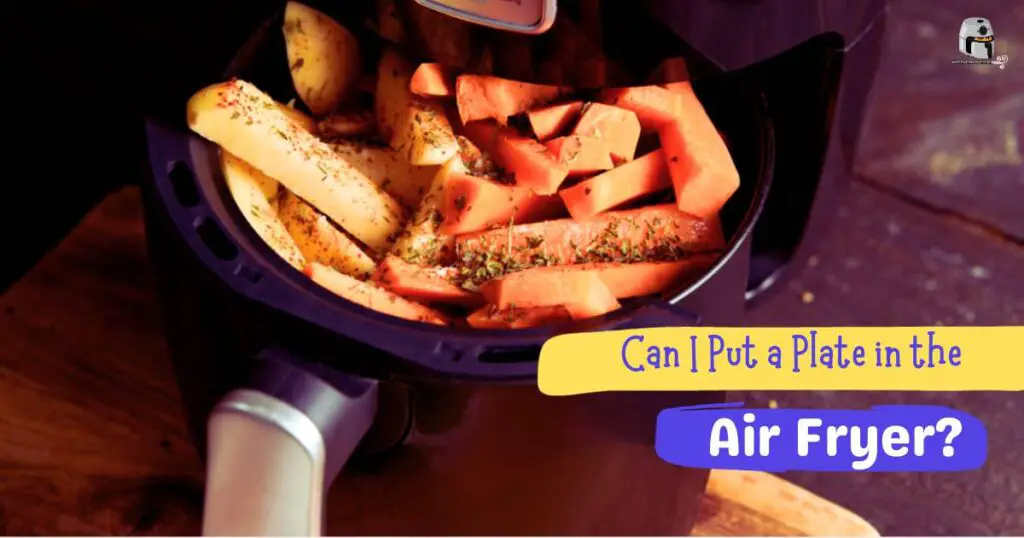Table Of Contents
Air fryers require proper ventilation to ensure efficient cooking. It’s advisable to have at least 5 inches of space around the appliance when in use, allowing for optimal performance. If feasible, position your air fryer in a well-ventilated area near a vent hood, ensuring the hood is activated while cooking.
In situations where this isn’t possible, opening windows can help with ventilation. Air fryers generate heat and cooking fumes, necessitating proper ventilation. Placing the air fryer near an open window or door is a straightforward ventilation solution.
Alternatively, models with built-in exhaust fans are available, effectively eliminating cooking heat and fumes from the process. By providing the recommended space and considering ventilation options, you can maintain the quality and efficiency of air frying.

The Importance of Ventilation in Air Fryers
Proper ventilation in an air fryer is a fundamental factor that greatly impacts its cooking performance, your kitchen environment, and even the longevity of the appliance. Let’s delve into the detailed importance of having adequate ventilation in your air fryer:
Consistent and Uniform Cooking
To cook food, air fryers use hot air circulation. Proper ventilation ensures that this hot air is evenly distributed throughout the cooking chamber. This uniform airflow is essential for consistent cooking results. It prevents the formation of hot spots or cold zones within the appliance, guaranteeing that your food is cooked thoroughly and evenly.
Odor and Smoke Control
During air frying, especially when cooking greasy or high-fat foods, cooking odors and even smoke can be produced. Adequate ventilation plays a crucial role in dissipating these odors and preventing smoke buildup in your kitchen. This is not only essential for a pleasant cooking environment but also for eliminating the lingering odors that certain foods may produce.
Steam Management
As food cooks, it releases steam. Without proper ventilation, this steam can condense on the interior surfaces of the air fryer. Excess moisture in the cooking chamber can compromise the crispness and texture of your dishes. Efficient ventilation ensures that excess steam is promptly removed, preserving the desired texture of your food.
Appliance Longevity
Air fryers comprise internal components like heating elements and fans. These components need a stable and regulated temperature to operate efficiently and extend their lifespan. Adequate ventilation helps maintain an optimal temperature within the air fryer, preventing overheating that could lead to component damage. In essence, proper ventilation contributes to the appliance’s durability and longevity.
How Do Air Fryer Ventilation Systems Work?
Air fryer ventilation systems are integral to their operation, as they play a multifaceted role in the cooking process. Here’s a detailed explanation of how these systems work:
Circulating Hot Air
At the core of air fryer ventilation is an internal fan. This fan propels hot air generated by the heating element around the cooking chamber. The hot air circulation ensures that food is evenly exposed to heat from all angles. As a result, dishes receive uniform cooking, and the outer layers become crispy, mimicking the texture of deep-fried food.
Moisture Control
During cooking, food naturally releases moisture, which can lead to undesirable sogginess. Air fryer ventilation systems are designed to tackle this issue. The fan also serves to evacuate excess moisture from the cooking chamber. By removing moisture, the air fryer maintains the desired crispiness of dishes like fries, chicken, and more.
Exhaust System
To prevent the accumulation of hot air, steam, and cooking odors within the appliance, air fryers are equipped with exhaust systems. These systems consist of vents and openings through which hot air and moisture exit the cooking chamber. These vents are strategically placed to facilitate the efficient removal of excess heat, humidity, and odors, ensuring a comfortable and safe cooking environment.
Safety Measures
In addition to improving cooking quality, ventilation systems also enhance safety. They aid in preventing the appliance from overheating by expelling excess heat. When the internal temperature rises to a critical point, the fan speed may be increased to cool down the air fryer, preventing potential damage or safety hazards.
Filtering Odors
Many modern air fryers incorporate filters into their ventilation systems. These filters help mitigate cooking odors, ensuring that the kitchen remains fresh and free from lingering food smells. They’re especially beneficial when preparing dishes with strong aromas.
Oil Management
The efficient circulation of hot air, combined with ventilation, reduces the need for excessive oil. This is advantageous for those seeking healthier cooking options, as air fryers use significantly less oil compared to traditional frying methods.
Read More:
- How Do I Keep Food From Blowing in My Air Fryer?
- 15 Common Reasons for Air Fryer Touch Screen Not Working
What if I Don’t Provide an Air Fryer With Ventilation?
Neglecting to provide an air fryer with adequate ventilation can have several adverse consequences:
1. Uneven Cooking
Achieving even cooking in an air fryer hinges on the presence of proper ventilation. It enables the hot air to circulate efficiently, ensuring that your food cooks uniformly. Without adequate ventilation, you risk facing undercooked sections alongside overcooked or even burnt portions, diminishing the quality of your meals.
2. Sogginess
Ventilation systems are designed to remove excess moisture released during cooking. In the absence of proper ventilation, this moisture accumulates and can result in soggy and less crispy dishes, defeating the purpose of using an air fryer.
3. Safety Concerns
Inadequate ventilation can lead to the overheating of your air fryer, posing significant safety concerns. Overheating may result in various issues, ranging from appliance damage to potential safety risks. It could trigger a shutdown of the appliance or, in extreme cases, cause electrical problems, even potentially becoming a fire hazard.
4. Odor Buildup
Cooking odors are a common byproduct when using air fryers, especially when preparing pungent or strong-smelling foods. Proper ventilation is crucial for dissipating these odors. Without it, these odors can accumulate in your kitchen and adjoining areas, creating an unpleasant, lingering smell. Adequate ventilation ensures a fresher and more pleasant environment.
5. Reduced Cooking Efficiency
In the absence of ventilation, an air fryer may need more time to cook your meals. This inefficiency can result in increased energy consumption and still yield less satisfactory results, which is both wasteful and frustrating. Proper ventilation guarantees efficient and effective cooking.
6. Maintenance Issues
Air fryers lacking proper ventilation may accumulate grime, residue, and food particles. This not only affects the appliance’s hygiene but also introduces maintenance concerns. Cleaning becomes more challenging and necessitates more frequent attention, which can be a hassle.
7. Health Implications
Air fryers are prized for their ability to reduce the use of cooking oils, contributing to healthier dishes. Inadequate ventilation, however, may lead to inefficient oil removal. This can result in oilier and less healthy meals, potentially affecting your dietary choices and health.
8. Limitations in Food Choices
Some foods, particularly those with heavy batters or coatings, release more steam and odor during cooking. In the absence of effective ventilation, you may find it necessary to avoid certain dishes or adjust your cooking techniques to adapt to the limitations of your air fryer. This can limit your culinary options and creativity in the kitchen.
How Should I Maintain and Clean the Ventilation System of My Air Fryer?
Maintaining and cleaning the ventilation system of your air fryer is essential to keep it running efficiently and to ensure the longevity of the appliance. Here’s a detailed guide on how to properly clean and maintain the ventilation system:
- Before you begin, unplug your air fryer and ensure it has cooled down after use to prevent any accidents or burns.
- Remove all the removable parts of the air fryer. This typically includes the cooking basket, trays, racks, and any other components that can be taken out.
- Inspect the interior of the air fryer for any food debris, grease, or oil splatters. Pay close attention to the area around the heating elements and the ventilation system. Wipe away any loose particles with a gentle brush or cloth.
- Wash the removable parts, such as the cooking basket and trays, in warm soapy water. If they are dishwasher-safe, you can place them in the dishwasher. Before reassembling, make sure they are thoroughly dry.
- Use a damp cloth or sponge to clean the interior of the air fryer. Be gentle to avoid damaging the non-stick coating or heating elements. Stubborn stains or residues can be tackled with a mixture of water and baking soda applied with a soft cloth.
- Wipe down the exterior of the air fryer with a damp cloth to remove any oil or food stains. Take care not to let water seep into the appliance, as this can damage it.
- The ventilation system is a critical component of your air fryer. It’s responsible for allowing hot air to circulate, which is vital for even cooking and maintaining the appliance’s temperature. Check the ventilation openings carefully.
- To clean the ventilation openings, use a small brush (a toothbrush or a dedicated appliance brush works well) or a cotton swab. Gently scrub away any accumulated oil, grease, or debris. This step is crucial for maintaining proper airflow.
- Some air fryer models have an exhaust fan. Refer to your user manual for specific instructions on how to access and clean the fan. Dust and debris can accumulate here, affecting the air fryer’s performance. Use a brush or compressed air to remove any obstructions.
- Once all parts are cleaned and thoroughly dry, reassemble the air fryer. Ensure everything is properly in place. Store your air fryer in a clean, dry, and well-ventilated area to prevent dust and debris from entering the appliance.
Factors to Consider When Providing an Air Fryer With Ventilation
When providing an air fryer with proper ventilation, several crucial factors should be considered. Adequate ventilation ensures the appliance operates efficiently and safely. Here are detailed factors to take into account:
- Space and Placement
Ensure the air fryer has sufficient space around it. There should be at least five inches of clearance on all sides. Placing the air fryer in an open area allows air to circulate effectively, preventing overheating. Avoid tight corners or placing them near flammable materials.
- Kitchen Ventilation
Ideally, position the air fryer in a well-ventilated area of your kitchen. Placing it close to a vent hood is beneficial. When cooking, turn on the vent hood to help disperse heat and odors produced during air frying. A well-ventilated kitchen improves air quality and prevents overheating.
- Windows and Doors
If a well-ventilated kitchen space isn’t available, open windows or doors during air frying. This creates a cross-ventilation effect, expelling heat, moisture, and odors outside. Cross ventilation aids in keeping your kitchen fresh and minimizes the risk of overheating.
- Built-in Exhaust Fan
Consider choosing an air fryer with a built-in exhaust fan. These fans enhance ventilation by efficiently removing heat and cooking fumes. Air fryers with exhaust fans are particularly beneficial in kitchens lacking proper ventilation. They ensure efficient heat dissipation.
- Ventilation System Maintenance
Regularly inspect and clean the air fryer’s ventilation system. Focus on the exhaust openings and vents. Removing accumulated grease, debris, or food particles is essential to maintain unobstructed airflow. Clogs can hinder proper ventilation.
- Use in Well-Ventilated Rooms
If you intend to use the air fryer in a non-kitchen area, ensure the room is well-ventilated. This means having good airflow in the room. Using the air fryer in a small, enclosed, or poorly ventilated space can lead to heat buildup and persistent odors.
- Manufacturer Guidelines
Always adhere to the manufacturer’s recommendations for air fryer placement, maintenance, and usage. These guidelines are designed to optimize the appliance’s function and ensure safe operation. Following them is crucial for efficient ventilation.
- Regular Cleaning
Routinely clean the interior and exterior of the air fryer. Pay close attention to the ventilation openings, exhaust areas, and the cooking chamber. Thorough cleaning prevents the accumulation of grease and debris, which can obstruct proper airflow.
FAQs
Is It Safe to Use an Air Fryer Without Ventilation?
No, it is not safe to use an air fryer without ventilation. Air fryers depend on hot air circulation to cook food. Without proper ventilation, pressure can build up inside the appliance, potentially causing it to burst or catch fire. Ensuring adequate ventilation is crucial for the safe operation of air fryers.
Where Should Air Fryers Not Be Placed?
Air fryers should not be placed on flammable materials like carpets or tea towels to avoid potential fire hazards. Only use them on kitchen surfaces designed to handle the heat produced during operation.
Can You Put an Air Fryer Under a Cabinet?
Yes, you can put an air fryer under a cabinet as long as there’s sufficient space between the fryer’s top and the cabinet’s base to allow for proper ventilation. Insufficient space may lead to heat accumulation and safety issues.
How Far From Wall Should Air Fryer Be?
For safety and efficient ventilation, maintain at least five inches of clearance around your air fryer. Adequate clearance allows the air vents to release heat effectively, minimizing the risk of fire hazards. Providing ample airflow space around your air fryer is crucial for both safety and optimal cooking performance.
Final Verdict
Unlock the secrets of air-frying perfection! Your air fryer craves space – a minimum of five inches from any wall or cabinet, to be precise. This is where the magic begins. Enhance this ballet of flavors by placing your air fryer close to an open window or vent hood, introducing a breath of fresh air into your culinary symphony.
Ignoring these airflow guidelines? Prepare for a culinary catastrophe – uneven cooking, sogginess, safety risks, stubborn odors, and dismal efficiency. Ventilation is your ticket to a world of culinary possibilities, where everyday dishes become culinary delights.
You May Also Like to Read:







